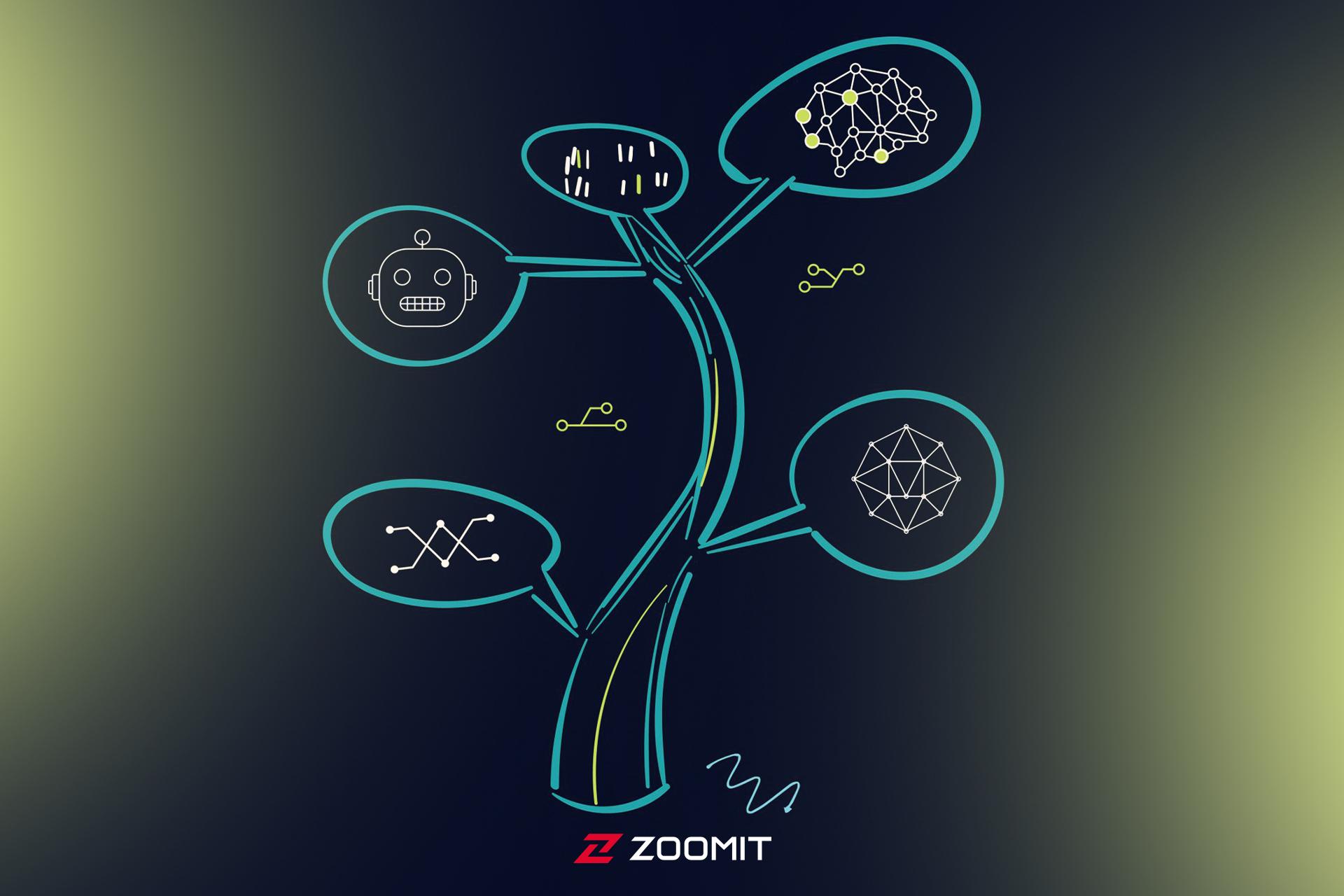Technology
Second WhatsApp , how to install and download dual WhatsApp August 2023
Published
9 months agoon


Download second WhatsApp, download dual WhatsApp, how to install second WhatsApp? How to install the dual WhatsApp and the new OGWhatsapp app, download GBWhatsapp. To install and download the second WhatsApp on your Android phone or iPhone and the dual WhatsApp with one number on your phone with a SIM card or for a second SIM card, read this article until the end. Also, in the future, we have put the link to download the OGWhatsapp application to install the dual WhatsApp.
In the following, you will explain the complete method of installing two WhatsApps and a second WhatsApp on Android and iPhone phones. We will show how you can have two WhatsApps simultaneously with one number by installing dual WhatsApp.
If you use two WhatsApp accounts on your smartphone, either Android or iPhone iOS, sometimes you will need to install the second WhatsApp on the same phone and use both simultaneously. Maybe you have WhatsApp Business, which of course, we will explain below what WhatsApp Business is and its uses.
For the second WhatsApp, download and install two WhatsApps for one number on the phone
Currently, WhatsApp is considered the largest smartphone messenger, with more than 2.5 billion active installations on Android and iPhone phones in world. The main goal of this messenger is faster communication between friends or relatives and family, and it seems that it has achieved success in this regard.
Although this application has some flaws, it is widely used and works better than many messaging applications. One of the significant problems with this messenger is when you want to communicate with your colleagues in Be connected, but if you do this on WhatsApp, friends or groups will send messages and disturb you. One of the solutions to get rid of this predicament is to install a dual WhatsApp account so that you can have two WhatsApps on one SIM card or two SIM cards simultaneously on your Android phone or iPhone.
Installing the second WhatsApp on older Android phones
In the video below, we see the installation of the second WhatsApp on older Android phones.
The second WhatsApp and installing the second WhatsApp at the same time on Android and iPhone
Download and install GBwhatsapp or GBWhatsapp, dual WhatsApp
The GB WhatsApp application is a modified version that allows you to install two versions of WhatsApp
simultaneously on the phone with a SIM card. This program is beneficial and practical and has the following features:
- It has the capabilities of the WhatsApp Plus version
- Call support
- Hide the possibility of appearing
- Security options
- Statistician for groups
- View multimedia files without loading
- Ability to hide name and date when there are two or more versions
- Ability to copy items
- Changing the program icon and notifications
Download GPWhatsApp for android
Second WhatsApp with OGWhatsapp 8.45 application, download and install
To install the second WhatsApp or the second WhatsApp, the version of the application that you can use to install the second WhatsApp on your phone is the OG Whatsapp or OGWhatsapp new version application. With the help of this application, you can easily install and use two WhatsApps simultaneously without changing the phone settings for two separate SIM cards. Among the features of this second WhatsApp application, the following can be mentioned:
- It is possible to download different themes and change the theme in OGWhatsApp.
- Warning when your contacts are online
- Disabling the blue and green tick in the OGWhatsApp application
- Ability to change the default image of the program
- Receive alerts when a new version of the app is released
- Sending more photos at the same time than the official version
- Send a larger file
- Ability to make voice and video calls on OGwhatsapp
- Ability to create groups and group chat with friends
- The ability to create a link for the Oji WhatsApp group
- Ability to delete the sent message after a specific time
- Ability to limit status and profile picture for your friends
- Added the ability to send messages between your friends
- Ability to tag your friends in the group
- Sending images and various files
- Ability to set the status
Download OGwhatsapp for android
Installing the dual WhatsApp on the Android phone and two WhatsApps on the phone
Install the second WhatsApp on Android and iPhone
Second, WhatsApp, new Android phones have a feature called app clone or app twin. This feature allows you to run most messaging or social networking apps in dual mode. You can use the twin app feature to install the second WhatsApp. Of course, you must have two separate SIM cards on the phone.
The possibility of installing a dual WhatsApp on the phone
- Create a new WhatsApp account on a phone
- Ability to display the status in any WhatsApp
- Hiding the overall status of each account
- The possibility of sending messages in two WhatsApps at the same time
- Ability to manage and control personal and business accounts
- Upgrades and other fixes


Now, the general method of installing the second WhatsApp on an Android phone:
- First, download and install the WhatsApp application from Google Play and register it with your original SIM card number.
- If you already have WhatsApp, you don’t need to do step 1; from this step, go to the Settings section of the phone.
- In the settings section, enter the Dual app, Clone app, or twin option. (If none of these three options is available, we will teach you how to install the second WhatsApp in another way in the last step)
- In this section, you can see the list of applications you can duplicate or have a second version installed on your Android phone.
- Then click on WhatsApp so the option to install the second WhatsApp will appear for you.
- In this section, click on the Agree and Continue option and confirm the allow permission section so that the installation of the second WhatsApp is done completely.
- The second WhatsApp has been installed. You can click on the dual WhatsApp and create a new account with a number other than your original.
To install the second WhatsApp, if you don’t find the option you want in the third section, you can first download the Parallel Space application from Google Play. After running it directly, you will have two WhatsApp applications on your phone.
Installing the second WhatsApp application on the iPhone
The method of installing the dual WhatsApp on iPhone is different. In the following, we will explain the general method of installing two WhatsApps on the iPhone.
Read more: Who saved our phone numbers , WhatsApp check
Of course, note that this method is applicable for iOS 12 and above:
- First, download and install the original version of the WhatsApp application from the App Store (if you don’t have it installed).
- Open the Safari browser and go to ios.othman.tv. In this section, click on the Whatsapp 2 option and then click the green button to download the second WhatsApp.
- You will be asked for permission to download and install the program. Click on the install option.
- When the installation is finished, go to settings-> General-> Profile and enable the trust VNE Software option.
- After this step, install WhatsApp 2. From now on, you will have two versions of WhatsApp on your iPhone.
There is another way to install the second WhatsApp on the iPhone, in this way, first, download the Dual messenger for Whatsapp application through this link and install it on your iPhone. After that, you can run the dual WhatsApp on the same application by scanning the QR code on this application.
What is WhatsApp Business, and what is its use for installing two WhatsApps simultaneously?
One of the latest applications introduced by WhatsApp is WhatsApp Business. By downloading WhatsApp Business, you can easily have an original version of WhatsApp and a version of WhatsApp Business on your phone and install the second WhatsApp. This application allows you to have a different logo, image or name on WhatsApp and to talk and exchange information with your colleagues and customers individually.
One of the ways to create a dual WhatsApp account is to install WhatsApp Business and register with a different number.


You may like
-






Who has checked our Whatsapp profile viewed my Whatsapp August 2023
-




The best brain multiplayer games for Android 2023
-

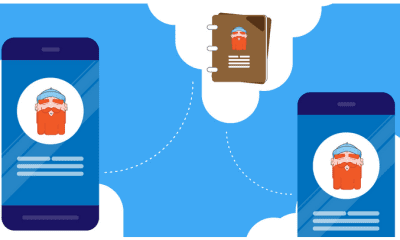


How to find out who has saved our number with what name
-




Who has saved our phone number in their phones 2023
-




Android smartphone security solutions
-

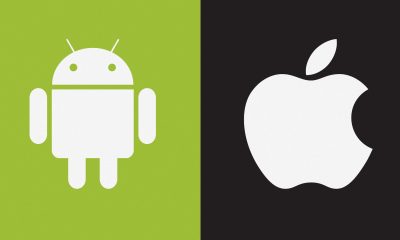


Converting Android phone to iPhone and iOS
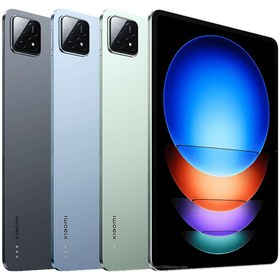

Xiaomi Pad 6S Pro review, economical iPad Pro
Tablets are the strangest gadgets in the world. At first glance, every user, seeing a well-made tablet, imagines that he must have one of them. A set of high-quality hardware in addition to an attractive form that is not as small as a mobile phone, which cannot be used for serious work, and does not restrict movement as much as laptops. It seems that such a device if it has a modern and appropriate design, can become an extremely useful tool that will significantly increase the level of your ability to produce content.
Laptops can have the same hardware as a powerful home computer. But they offer this power in a portable form, and for that reason, they are gadgets that are hard to replace. To solve the challenges of working with mobile phones, laptops provide the user with a much larger screen, physical keyboard, multiple ports, and extensive communication capabilities, and they handle complex and heavy tasks well; Whether you are a professional programmer, a video editor or a gamer.
Finding a place between smartphones and laptops is the most difficult task for a tablet
As a result, tablets have to prove themselves in a space that is well covered by mobile phones on the one hand and laptops on the other hand. For this reason, many users do not consider buying a tablet a good choice. But definitely, for every user, there has been a time when he feels that neither a mobile phone nor a laptop can do a certain task in the best way, and a tablet is the best option to do that task.
Of course, the “special work” of each user can be different depending on the job or hobby of each person. You may be a professional reader who has decided to buy e-books instead of paper books; Or the mobile gamer who feels that the dimensions of the phone cannot develop all his talents in Call of Duty Mobile and needs a device with a larger screen for this. Or an employee who spends a large part of his daily activity reading e-mails, managing the flow of projects, and participating in video conferences, and needs a more specialized device than a phone, but more portable than a laptop to do these things.
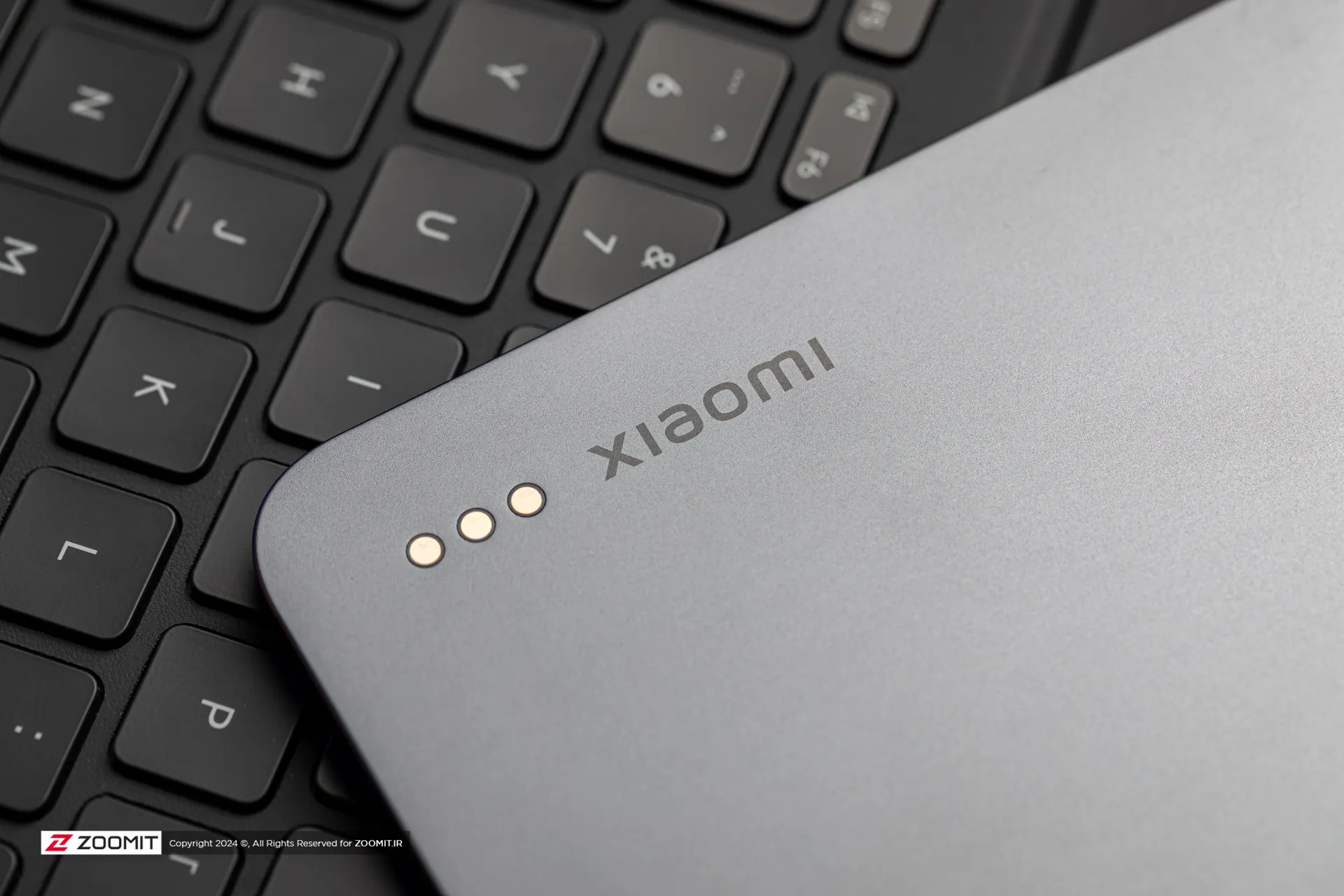
But as much as iPads are successful in filling this technological gap, Android tablets are not welcomed by users. According to the latest statistics, in February 2024, Apple had more than 54% of the tablet market, followed by Samsung with 27% and Amazon with 3%. This statistic clearly shows that many users believe that “an Android tablet is just an Android phone with bigger dimensions”.
Is an Android tablet more than just a large Android phone?
Samsung has been trying to erase this notion from the minds of users for years. Whether he has succeeded in doing such a thing or not is a matter that should be addressed separately. But gradually, another name appears in the campaign to challenge iPads, more prominently than before: Xiaomi.
2023 was a relatively busy year for the Xiaomi tablet unit. Xiaomi Pad 6, Xiaomi Pad SE, Xiaomi Pad 6 Pro, and Xiaomi Pad 6 Max were the tablets that were introduced by the Chinese company and now it is time for the first model of 2024. The Xiaomi Pad 6S Pro is a device introduced to compete with the iPad Air 2022 and the Galaxy Tab S9 FE and aims to show that Android tablets are much more useful than you might think.
|
List of hardware specifications of Xiaomi Pad 6S Pro |
|
|---|---|
|
Specifications |
Description |
|
Dimensions (mm) |
287.7 x 191.6 x 6.3 |
|
weight (gram) |
590 |
|
Display dimensions |
12.4 inches with a 3:2 aspect ratio |
|
Display technology |
IPS LCD – supports 68 billion colors 144 Hz refresh rate Maximum brightness of 900 nits |
|
chipset |
Snapdragon 8 Generation 2 |
|
RAM and storage space |
256GB 8GB RAM, 256GB 12GB RAM 512GB 12GB RAM, 1TB 16GB RAM |
|
Main camera |
50 megapixels f/1.8, 1/2.76-inch sensor |
|
filming |
4K@30/60fps 1080p@30/60fps |
|
selfie camera |
32 megapixels |
|
Battery capacity |
10000 mAh |
|
fast charging |
120 watts (0 to 100 in 35 minutes) |
The iPad of the Chinese
Although Samsung and Apple tablets share many similarities, the Xiaomi Pad 6S Pro bears an undeniable resemblance to the iPad Pro. The aluminum body and frame with low bezels around the display and perhaps most importantly, the square-shaped camera island on the back of the device are undoubtedly reminiscent of the iPad Pro. Of course, considering Apple’s very high share of the tablet market, Xiaomi seems to have made the right decision regarding the design inspiration of the 6S Pro pad from iPads.

You probably also agree that years of using smartphones with glass bodies have made us forget the feeling of holding aluminum gadgets. But as soon as you hold the pad of the 6S Pro, the memories of the past come alive and you can again experience the pleasant feeling of touching a body with cold metal.
Revisiting the aluminum body is really enjoyable!
Xiaomi Pad 6S Pro has a thickness of 6.3 mm, which is almost equal to the thickness of the iPad Air 6.1 mm and Galaxy Tab S9 FE 6.5 mm (as its price competitors in the Iranian market). However, the weight of the Xiaomi tablet is significantly more than the competitors. Where the scales tip, the 590g Pad 6S Pro is almost 130g heavier than the iPad Air and 67g heavier than the Galaxy Tab S9 FE.
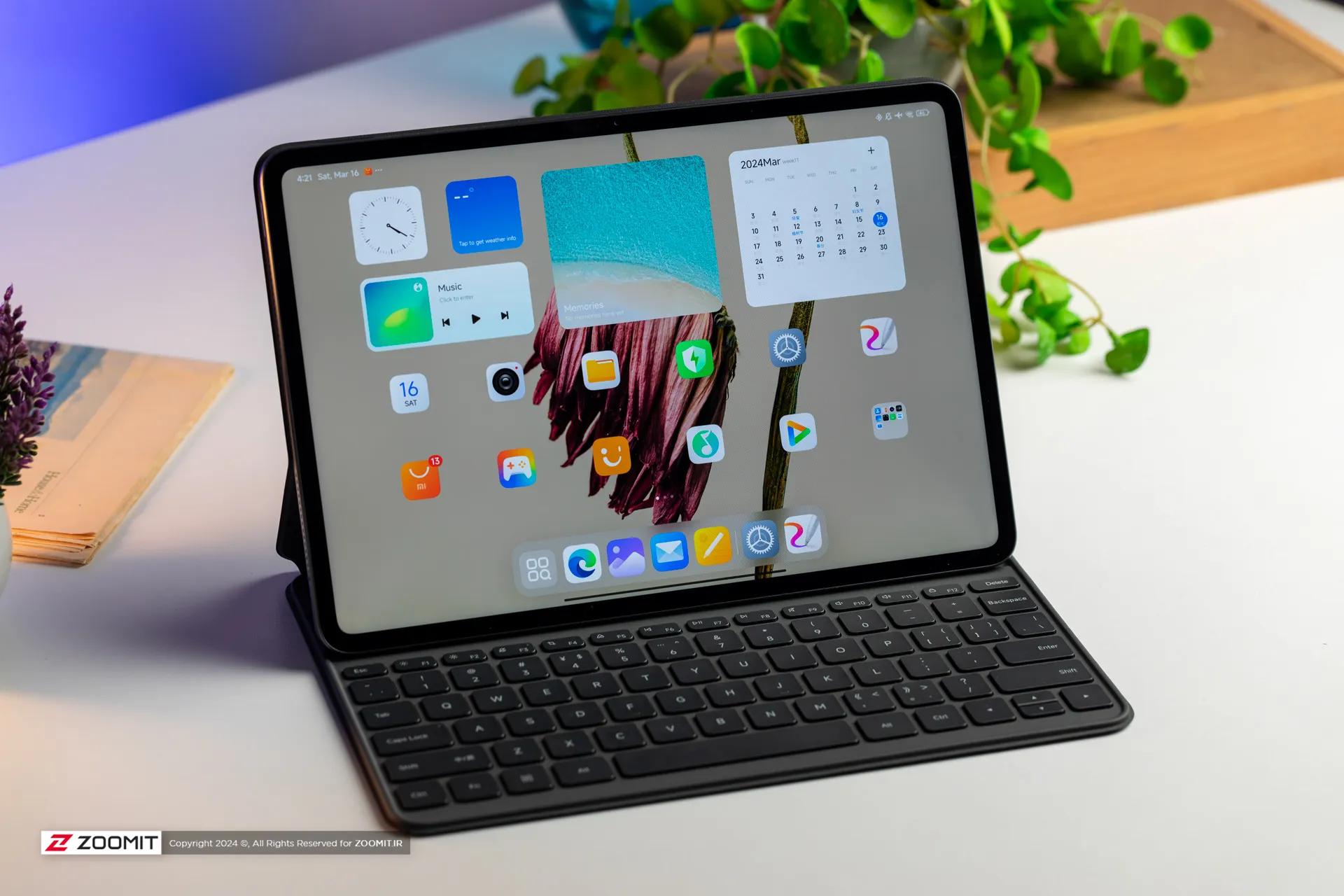
Although this number is by no means negligible, you should not forget that both Apple and Samsung tablets are 10.9 inches (against the 12.4-inch screen of the Xiaomi tablet). However, in the world of tablets and according to the size and model of the use of these gadgets, the weight is higher, much more than 1.5 inches, and the screen is bigger. The result of this greater weight is faster hand fatigue during work and the greater tendency of the user to place the tablet on a surface such as a table.
Borrowing from Apple’s design can be seen even in the location of the device’s physical keys. You can find the volume keys on the top right edge of the tablet, and the power key is located on the right corner of the top edge of the device, just like the iPad Air. As expected, this key also plays the role of a fingerprint sensor.

Around the body, you can also see a set of 6 stereo speakers of Xiaomi Pad 6S Pro. This set not only helps produce loud and clear sound in different audio frequencies but also supports Dolby Atmos, giving you a better experience while watching movies and video conferences. Of course, there are probably very few users who still prefer to hear the sound of the movie through the tablet speakers instead of using Bluetooth hands-free! Also, there is no news about the 3.5 mm headphone jack.
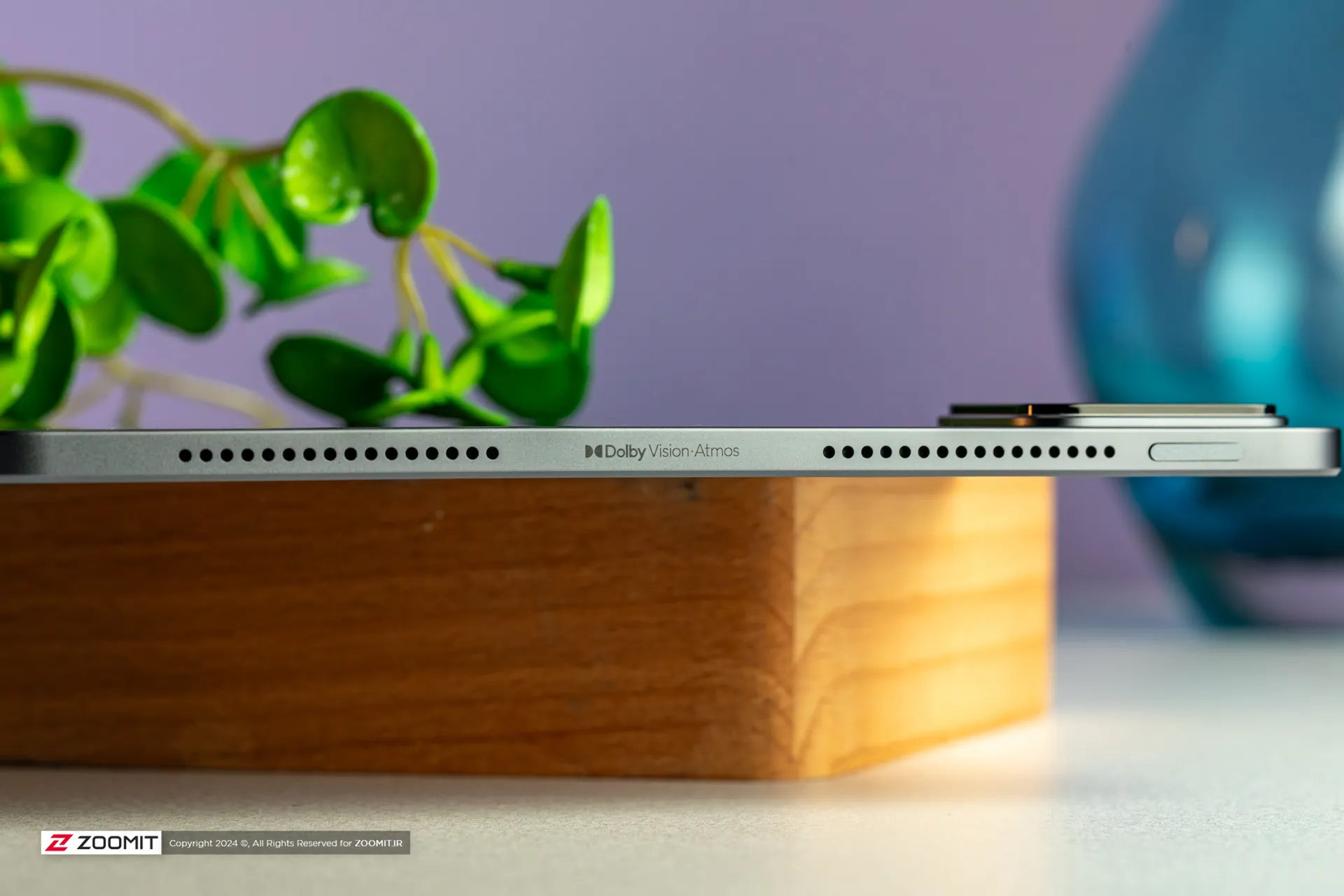
More than 85% of the device’s front view is covered by its 12.4-inch screen. The screen-to-body ratio in the Xiaomi Pad 6S Pro is almost 4% higher than the same figure in the iPad Air and Galaxy Tab S9 FE, and Xiaomi should be given credit for its effort in reducing the screen margins. Of course, this issue can be looked at from a different angle.

When you hold a tablet in your hand, you need space around the screen to place your fingers. This procedure is unlike smartphones, in which mainly the hand that is behind and the finger that is placed under the phone are also responsible for protecting it. As a result, reducing the bezels around the screen of a tablet too much is probably not a very good decision. However, Xiaomi has decided to take a little risk and move a few more steps towards the limit and ultimate convenience of using a tablet.
Perhaps the use of a relatively high-quality screen has made Xiaomi accept the risk of reducing the margins around it in order to expose the screen in the best way to the users. The screen of Xiaomi Pad 6S Pro is IPS LCD type with 3K resolution, the maximum announced brightness is 900 nits and the refresh rate is 144 Hz, which is much higher than the 60 and 90 Hz screens of Apple and Samsung.
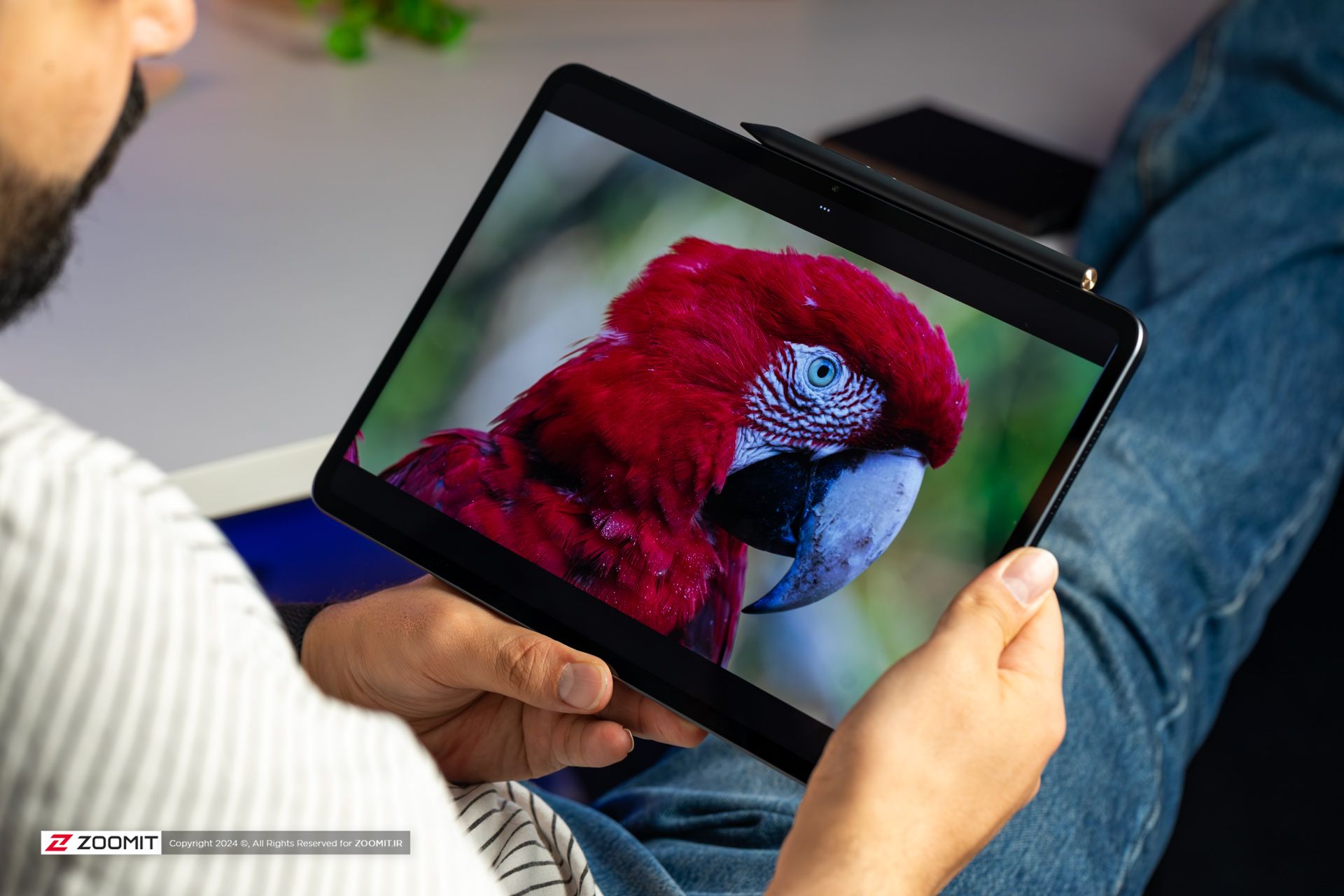

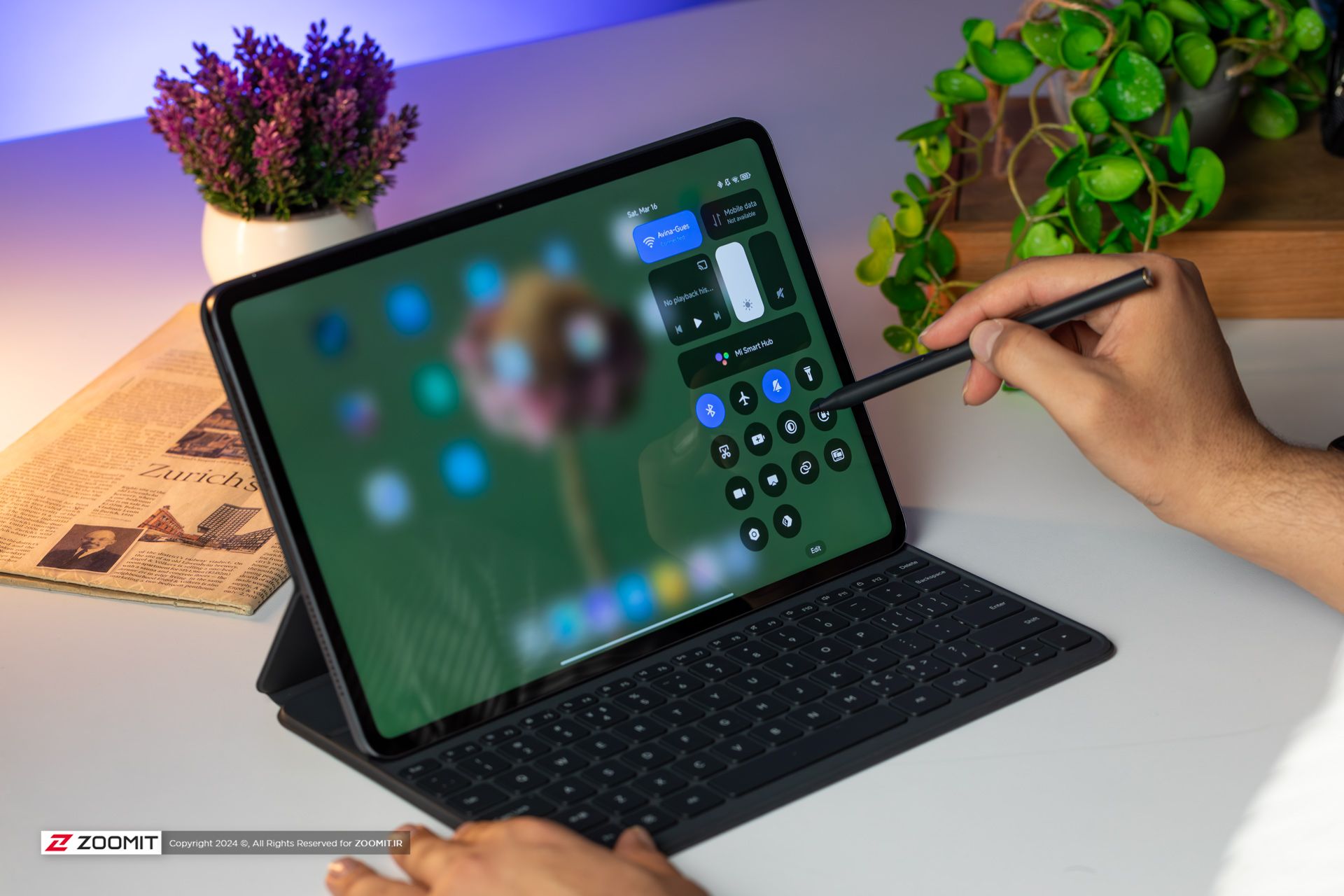
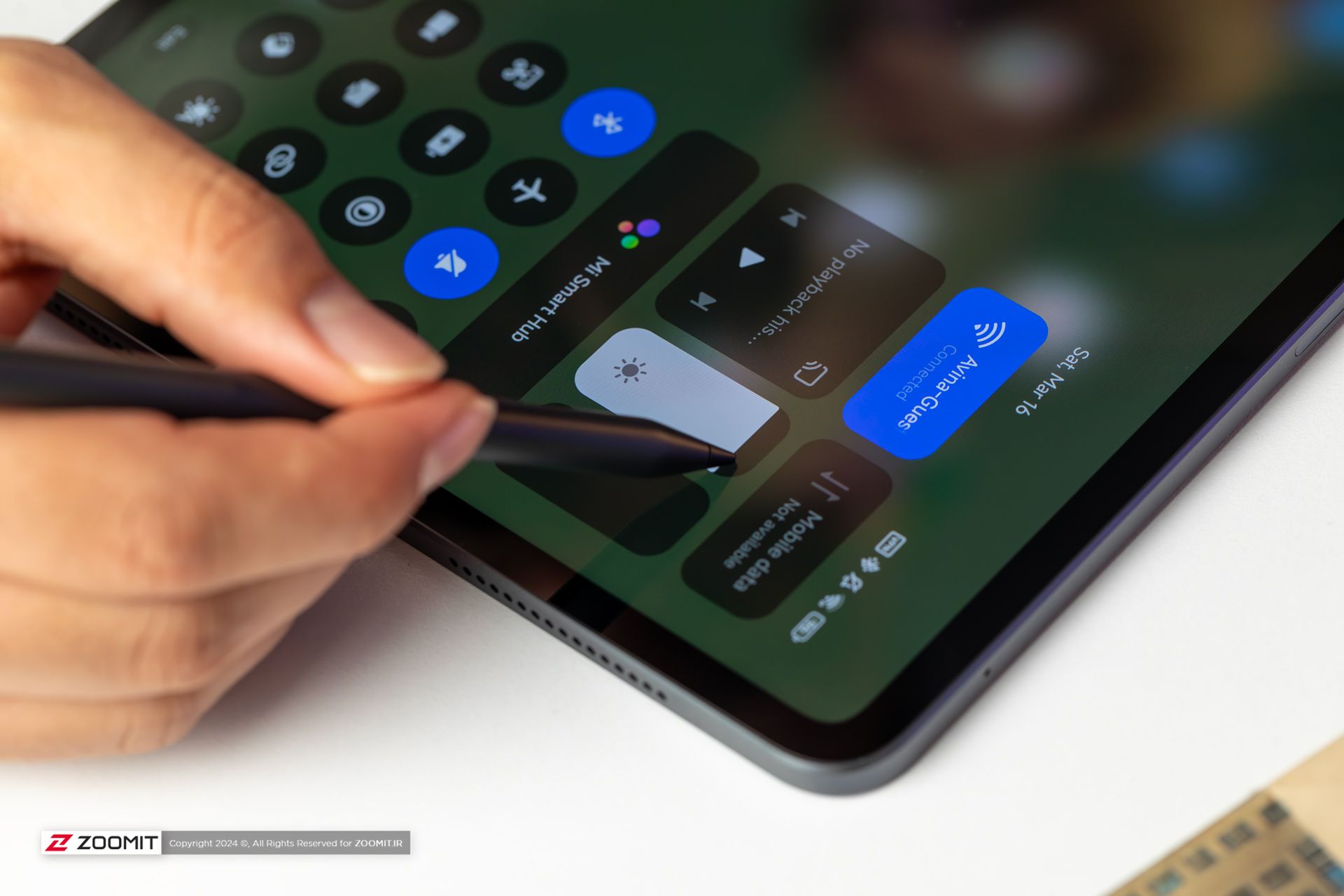
Of course, the IPS LCD screen and its similarity with the panel of competitors of the same price do not disappoint us, but maybe you also expect to see an OLED panel on a tablet with the specifications and of course the price of Pad 6S Pro.
The pixel density of 295 ppi is another strength of this display, but the best aspect ratio should still be given to the iPad Air. It seems that the 4:3 aspect ratio in Apple tablets provides users with the best possible mode for using a tablet. While the 3:2 aspect ratio on the Xiaomi Pad 6S Pro is much better than the weird 16:10 that many other tablets (including Samsung’s) use, it’s still a step down from iPads in terms of usability.
Read more: Motorola Edge 50 Pro review, technical specifications
|
Xiaomi Pad 6S Pro display performance against competitors |
|||||||
|---|---|---|---|---|---|---|---|
|
Product/Test |
Minimum brightness |
Maximum brightness |
contrast ratio |
sRGB |
DCI P3 |
||
|
manual Automatically |
local |
cover |
Average error |
cover |
Average error |
||
|
Xiaomi Pad 6S Pro |
5 |
547 780 (HDR) |
156 |
99.4 percent |
3.2 |
97.9 |
4.2 |
|
Galaxy Tab S9 Ultra |
2 |
502 910 (HDR) |
∞ |
100% (Original) |
1.8 |
130 percent (Vivid) |
3.4 |
|
Xiaomi Pad 6 Pro |
0.6 |
332 415 |
553 |
96.9 percent |
2.5 |
98.5 percent (Saturated) |
3.4 |
|
iPad Pro 12.9 2022 |
1.7 |
566 1532 (HDR) |
∞ |
100 percent |
1.8 |
— |
— |
|
iPad Pro 11 2022 |
2.40 |
509 518 |
706 |
100 percent |
2.3 |
— |
— |
|
Galaxy Tab S8 Ultra |
2.0 |
527 943 (HDR) |
∞ |
100 percent (Natural) |
3.1 |
100 percent (Vivid) |
5.4 |
As you can see in the table, contrary to Xiaomi’s claim of a maximum brightness of 900 nits, in Zoomit tests the maximum brightness of the Pad 6S Pro screen in HDR mode is about 780 nits. Although under normal conditions, screen brightness is not a problem, when playing video or working with the device under sunlight, this point should be considered.
On the other hand, the accuracy of the Xiaomi Pad 6S Pro screen should be considered one of the strengths of this tablet. The coverage of more than 99% of the sRGB color space and nearly 98% of the DCI-P3 color space and an error of less than 5% in both modes indicate the production of accurate colors in this display, which will be a positive point for those interested in watching video content.
Another noteworthy point about the display is the ability to adjust the temperature and brightness of the screen based on environmental conditions, which makes the tablet a suitable option for those interested in reading.
Despite the acceptable technical performance of the screen in Pad 6S Pro, it seems that the distance between the protective glass of the screen and the panel is a little high; For this reason, a little shadow can be seen on the edges of the page. If you have sharp eyes, such an issue may get on your nerves while working with a tablet.
Chip; The trump card of the Pad 6S Pro
Unlike Samsung, which has used the disappointing Exynos 1380 chipset for its representative in this price range, Xiaomi has gone to a more powerful competitor to challenge the iPad Air equipped with the M1 chipset. The SD 8 Gen 2 chip is the mastermind of the Xiaomi Pad 6S Pro, which can easily turn the Chinese tablet into a tool to accomplish any task with any level of complexity and technical power required.
|
Performance of Xiaomi Pad 6S Pro against competitors |
|||||
|---|---|---|---|---|---|
|
Product/benchmark |
chip |
Speedometer 2.0 |
GeekBench 6 |
GFXBench |
|
|
Web browsing experience |
GPU computing power |
CPU computing power |
Game simulator |
||
|
Vulkan/Metal |
Single/Multi |
Aztec Ruins Onscreen/1440p |
|||
|
Vulkan/Metal |
|||||
|
Xiaomi Pad 6S Pro |
Snapdragon 8 Gen 2 |
156 |
8667 |
1915 5254 |
41 65 |
|
Galaxy Tab S9 Ultra |
Snapdragon 8 Gen 2 |
193 |
9661 |
2022 5377 |
50 68 |
|
Pad 6 pro |
Snapdragon 8+ Gen 1 |
124 |
6999 |
1756 4433 |
34 47 |
|
iPad Pro 2022 |
Apple M2 |
373 |
45395 |
2527 9576 |
81 75 |
|
Galaxy Tab S8 Ultra |
Snapdragon 8 Gen 1 |
102 |
6887 |
1629 3663 |
28 37 |
|
iPad Pro 12.9 2021 |
Apple M1 |
212 |
— |
2400 7871 |
52.8 68.2 |
In terms of processing performance, Xiaomi Pad 6S Pro has recorded acceptable results as an Android tablet, but there are controversial points in the benchmark results of this tablet that cannot be simply ignored. First of all, the Xiaomi tablet’s chipset is a few steps below Apple’s M1. By comparing the numbers recorded by the Pad 6S Pro with the benchmark results of the iPad Pro 2021 (which uses the same M1 chip used in the iPad Air 2022), you can clearly see the difference in performance.
Unfortunately, Snapdragon 8 generation 2 still has a significant gap with Apple’s chipsets
Despite having the same chipset as a tablet like the Galaxy Tab S9 Ultra, the Xiaomi tablet cannot record the same results as the Samsung representative and is still ranked lower. For example, in the GPU computing power test, the Xiaomi Pad 6S Pro is about 10% weaker than the Galaxy Tab. This result is repeated in the CPU computing power test and the game simulation test (although with a smaller difference). Of course, it can be justified that the price of the Galaxy Tab S9 Ultra is 2 times higher than the price of the Xiaomi representative, and yet the difference of 10% is not such a big difference.
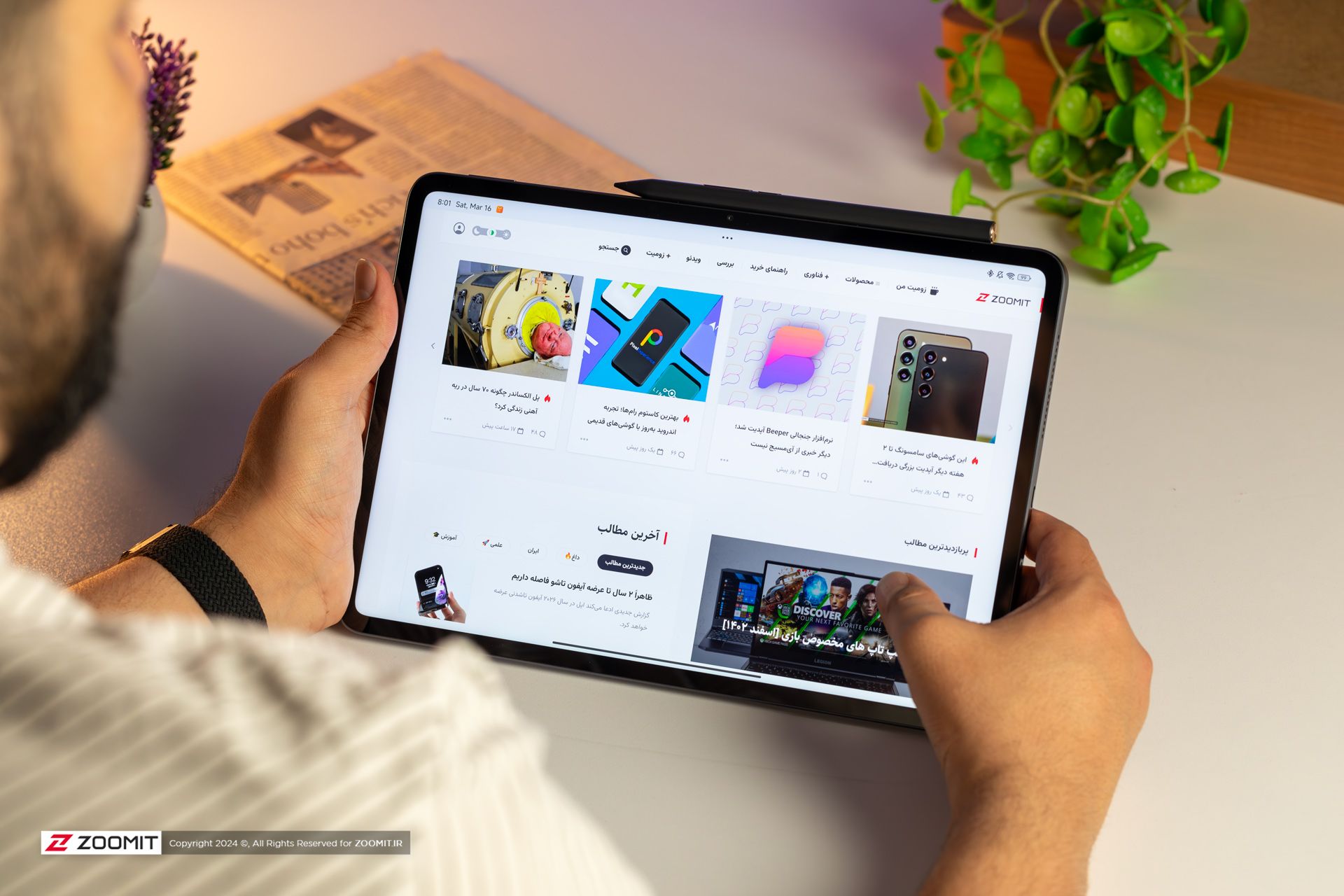
Aside from the benchmark results, one thing to note is that the Snapdragon 8 Gen 2 will handle almost anything, and there is probably no usage scenario that will cause the device’s chip to hang or feel weak.
The UFS 4.0 storage space makes the speed of reading and writing information no less than the best tablets on the market. The Pad 6S Pro in the basic configuration offers 8GB of RAM and 256GB of storage space, which was also available to Zoomit for review. In addition, except for this model, users will also be able to choose versions with 12 or 16 GB of RAM and 512 GB or 1 TB of storage space.
When we talk about the hardware power of the tablet, it is not bad to keep in mind that unlike Samsung and even Apple, Xiaomi’s user interface does not provide the user with special features for multitasking, and features such as the ability to open four windows at the same time. In Workstation mode, they do not put any special pressure on the device. With this account, it can be said that the processing power of SD 8 Gen 2 for Xiaomi tablet is considered “Overkill” to some extent.
HyperOS experience; Repetitive and not very useful
Perhaps the main distinguishing feature of tablets should be found in their user interface and user experience. After the retirement of MIUI, Xiaomi has tried to design its new user interface, Hyper OS, simpler and lighter and provide as many features as possible to users. Among the features of HyperOS in Xiaomi Pad 6S Pro is a special video conference mode (using artificial intelligence to remove microphone noise), a very powerful file management system (File Manager), which Xiaomi considers to be on par with the file management system of laptops, the possibility of using He mentioned the tablet as a second screen for photography and video cameras and of course a new feature called Interconnectivity.
With Interconnectivity, Xiaomi wants to evoke the ecosystem of Apple and Samsung for users
Interconnectivity is actually Xiaomi’s attempt to create integration between the company’s products and provide conditions such as perfect coordination of iOS and iPad, in order to create a platform similar to what Apple provides to its users for Xiaomi fans.
The Interconnectivity feature is created by a Xiaomi user account between different devices and features such as a central hub for controlling smart home appliances, the possibility of Drag&Drop files between different devices, the ability to convert the main phone camera into a tablet selfie camera in video calls, or work with the phone. It makes it available to users through tablets.

After creating a Xiaomi account (or logging in) and issuing the necessary access to Interconnectivity, in the quick settings section of the tablet, you will have a new option called Mi Smart Hub through which you can access all other devices that support this feature. View and control.
For example, let’s say you have connected your tablet and phone through Interconnectivity. Here you can use the phone as an independent and external camera and take photos or videos through the tablet. If you’ve ever tried to record a video for YouTube or Instagram on your own, you know how much of a hassle it can be to adjust the frame, focus, brightness, and sidelights. But now with a tablet and a Xiaomi phone that support Interconnectivity, you can easily have your own personal studio!

The next interesting feature is the ability to type or navigate the phone through the tablet. If for some reason you intend to draw a shape on your phone, you can do it on the larger screen of the tablet with the help of a dedicated pen, which undoubtedly provides more precision and control. In such a case, applying changes at high speed and without slowness or lag is a very important point that Interconnectivity provides you.
Apart from these cases, Xiaomi has tried to add a feature similar to Airdrop to its devices. This feature, called Mi Share, works exactly like Airdrop in Apple products, and you can use it to transfer files between different Xiaomi devices. Of course, this feature seems to be compatible with other Android devices as well, but at least in our tests, it was not possible to transfer files from tablets to Samsung phones, which may be due to the presence of Chinese ROM, or a software bug that can be solved in the future.
Along with the Pad 6S Pro, a keyboard and a special pen called the Xiaomi Pad 6S Pro Cover and Xiaomi Focus Pen have also been introduced to increase the productivity aspect of the tablet. The pen is magnetically connected to the Xiaomi Pad 6S Pro and is charged in this way. With the support of a 240 Hz touch sampling rate and 4096 pressure levels, this pen is considered a very good option for designers. The interesting thing is that the focus pen of the Xiaomi stylus is very similar to the Apple Pencil and, like the overall design of the 6S Pro pad, it was directly inspired by Apple.

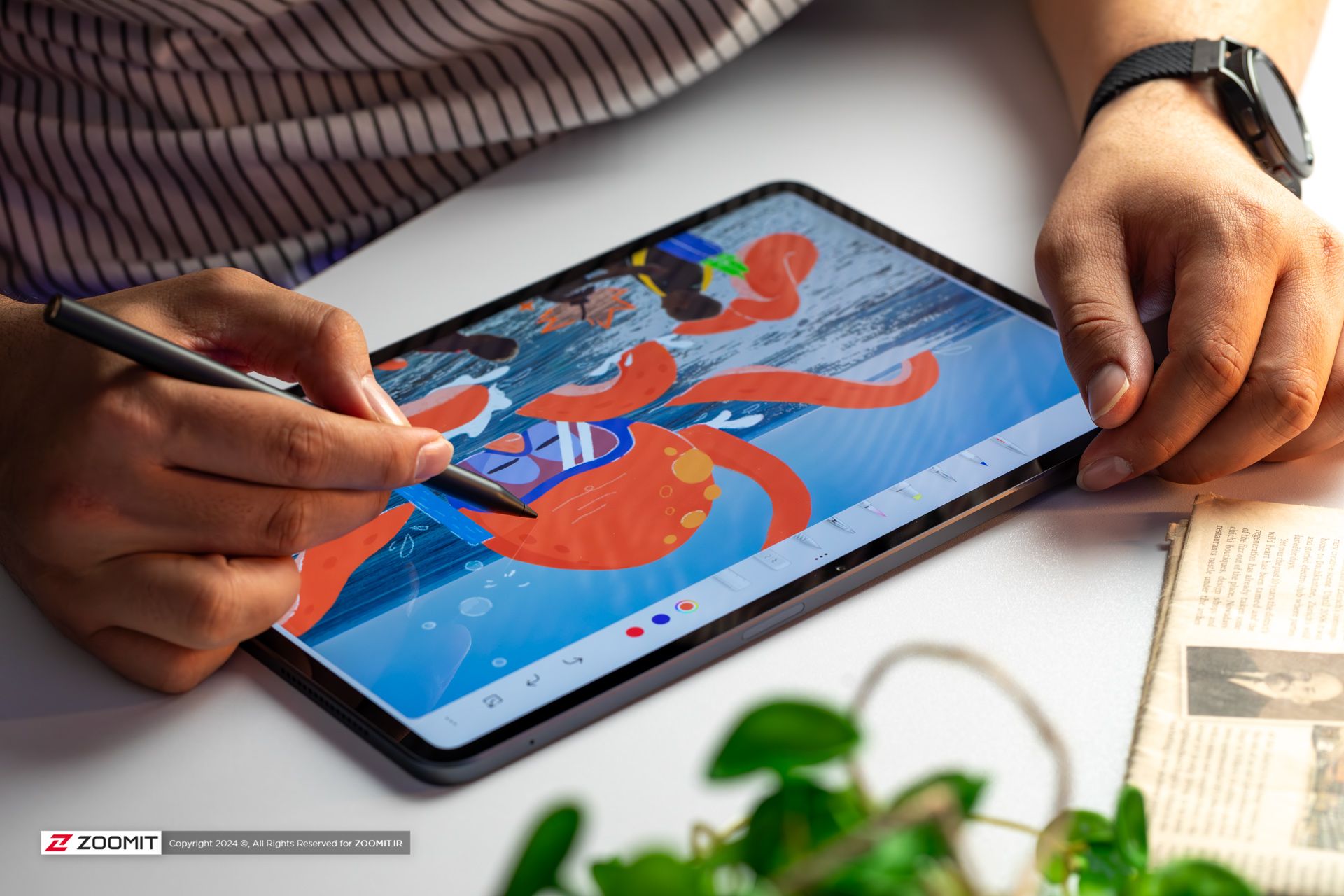
The keyboard is connected to the tablet through the pins on the back of the device and simultaneously plays the role of the cover. Of course, it seems that this keyboard was designed for the Chinese market, and some software limitations (such as not being able to set the Farsi language for typing) can be seen in it. A trackpad is not considered for this keyboard, which seems a bit strange, but as a means to get rid of the virtual and touch keyboard of the tablet, it will be a logical option.
The camera set is quite adequate
Although probably no one expects photography from tablets, Xiaomi offers a camera with a 50-megapixel sensor for necessary occasions. The maximum aperture of this camera is f/1.8 and the dimensions of its sensor are 1/2.76 inches. With this camera, you can easily scan documents, or if you are in a business meeting or classroom, take a quick picture of the board and the information written on it. The quality of the images in this condition is quite acceptable and no particular fault can be found in them.
Another 2-megapixel camera is intended to help detect depth, which is not particularly useful in normal photography. The possibility of recording videos with 4K or 1080p resolution at a maximum rate of 60 frames per second is also available to users by the main camera.
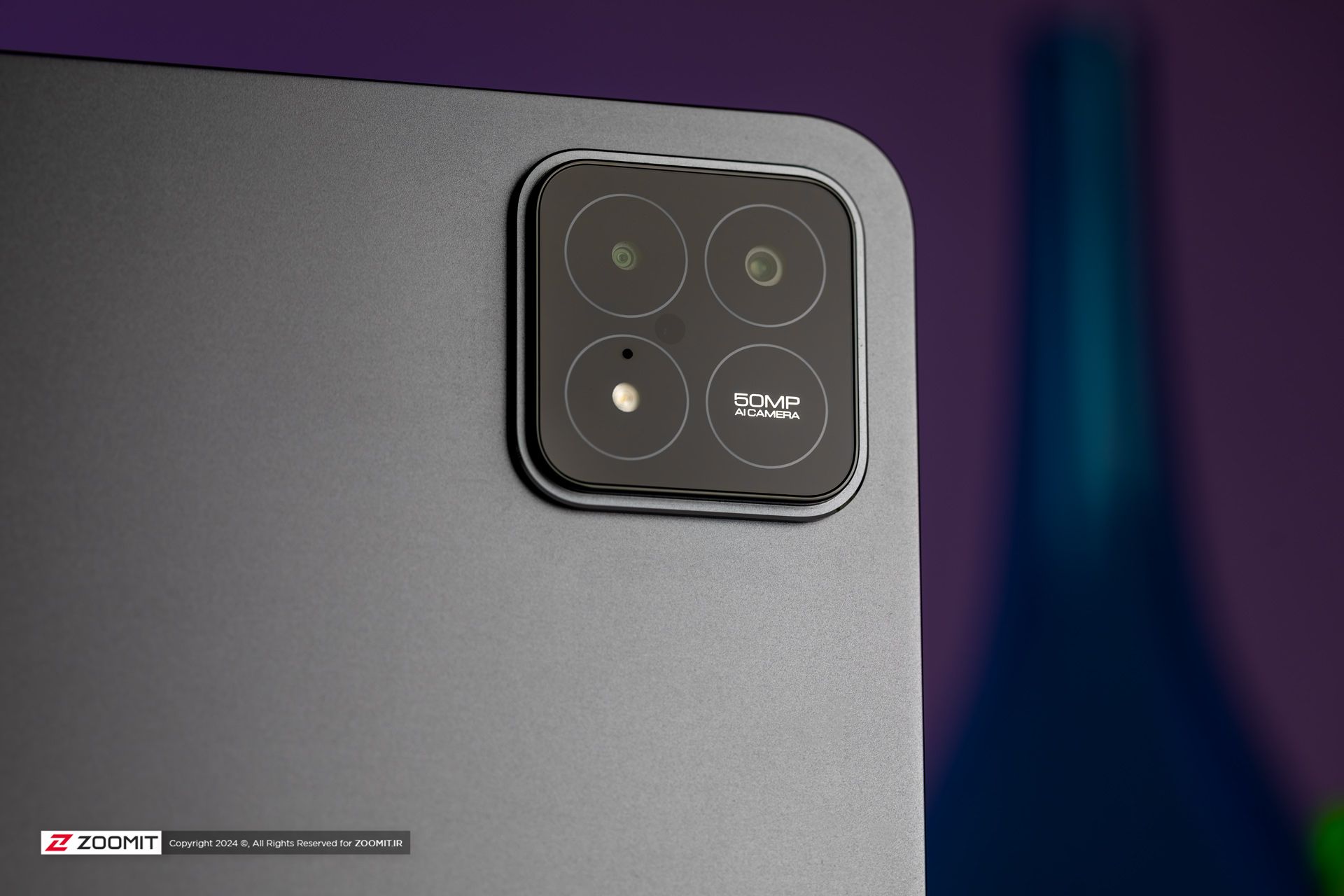
Attending video conferences is one of the main uses of tablets. For better video quality in video calls, Xiaomi Pad 6S Pro uses a 32-megapixel selfie camera. This camera is placed on the vertical edge (when you hold the tablet in portrait mode), which is the best way to use it in video conferences.
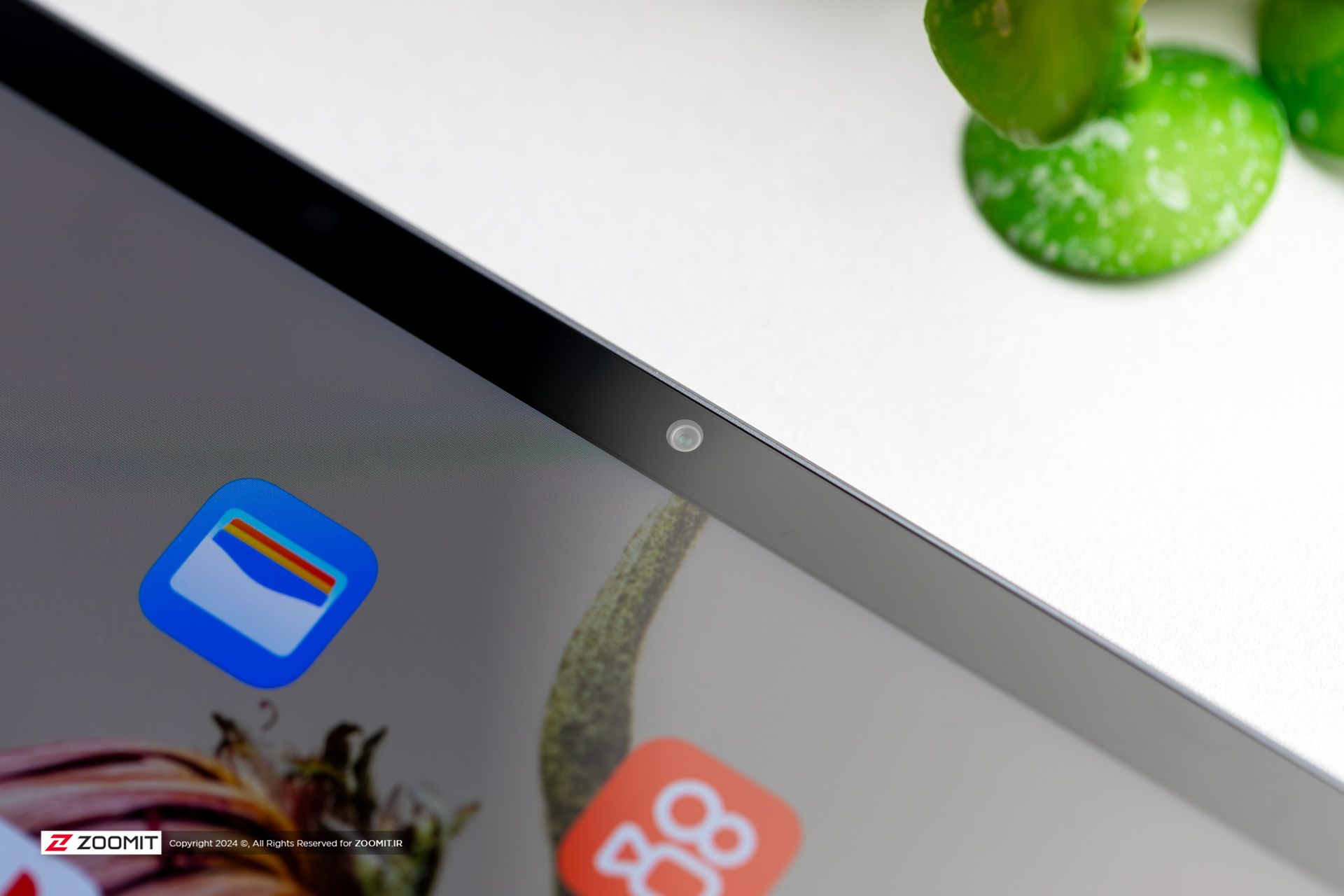
The selfie camera also uses the Focus Frame feature, which, similar to the Center Stage feature on Apple tablets, keeps the subject always in the center of the frame when using the front camera.
Large battery with reliable charging
Xiaomi has used a giant battery with a capacity of 10,000 mAh in the Pad 6S Pro, which is a leader in its kind and compared to competitors. It is worth noting that the battery used in the iPad Air 2022 has a capacity of 7600 mAh, and the Samsung Galaxy Tab S9 FE uses a battery with a capacity of 8000 mAh. Meanwhile, while the Samsung tablet supports 45W fast charging, the Xiaomi Pad 6S Pro can be charged with a 120W adapter, which, according to Xiaomi, charges the tablet from zero to 100% in just 35 minutes. Thanks to the use of Quick Charge 4.0 technology, you will only need 10 minutes to charge the tablet from zero to 45%.
|
Battery life of Xiaomi Pad 6S Pro against competitors |
||||
|---|---|---|---|---|
|
Product/benchmark |
Display |
battery |
Play video |
Everyday use |
|
Dimensions, resolution, and refresh rate |
milliampere hour |
minute: hour |
minute: hour |
|
|
Xiaomi Pad 6S Pro |
12.4 inches, 144 Hz 2032×3048 md; sg |
10000 |
17:00 |
8:25 |
|
Galaxy Tab S9 Ultra |
14.6 inches, 120 Hz 2960×1848 pixels |
11200 |
17:00 |
— |
|
Pad 6 pro |
11 inches, 144 Hz 2880 x 1800 pixels |
8600 |
12:30 |
7:18 |
|
iPad Pro 2022 |
11 inches, 120 Hz 1668 x 2388 pixels |
7812 |
10:07 |
— |
|
Galaxy Tab S8 Ultra |
14.6 inches, 120 Hz 2960×1848 pixels |
11200 |
16:50 |
7:30 |
In Zomit’s daily user test, Pad 6S Pro was able to record a charging time of about 8.5 hours, which is not a bad number considering the LCD display. We also obtained 17 hours of device performance in the video playback test. In general, and according to the results of the tests, we have to classify the charging of the 6S Pro pad as one of its strengths.

However, Xiaomi has a very long and difficult road ahead of it. Even in the Android world, there are exciting features like Samsung Dex that can attract more users, and cross-device integration shouldn’t just be limited to flagship phones and tablets. If Xiaomi can draw a clear vision in this direction and show that it is determined to achieve it, it will meet with more favor from users.
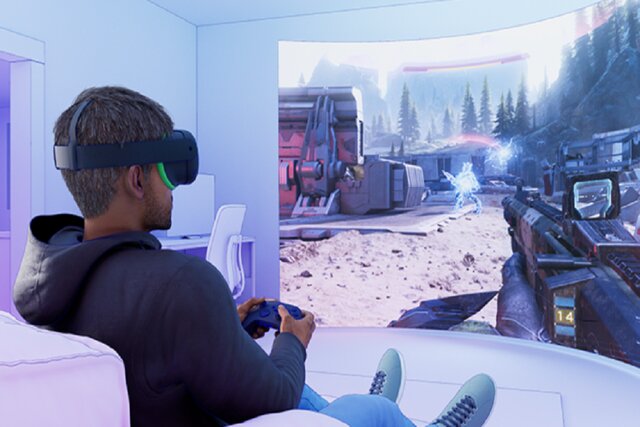

Talk of Metaverse technology has been muted in recent months, but Meta CEO Mark Zuckerberg changed that with an Instagram post that could have a significant impact on the development of the best VR headsets and accelerate the pace of Metaverse.
Metaverse is back
The big news is that Meta will open-source the mixed reality operating system it developed for the Quest 3 headset and previous Quest VR headsets to expand the ecosystem with new partners.
Meta built what is now known as Horizon OS with the Android Open Source Project, and now an optimized XR version of Meta will be available for other manufacturers to use on their hardware.
Few details have been shared, but Meta’s blog says that Asus ROG is working on a gaming headset, Lenovo will develop one, and Meta is working with Microsoft on a limited-edition Xbox-inspired Quest. ) cooperates.
Other companies may build devices for specific uses, such as productivity, fitness, watching video, or playing 2D games on a large virtual screen, Zuckerberg said. A dedicated virtual reality headset designed for simulation can start working with Horizon OS.
Read more: AI PC; revolutionary technology of the future?
As part of this change, Meta is updating its Quest app store, which will become the Horizon Store. Anyone running Meta Horizon OS can see compatible apps in the Horizon Store, and more content is on the way.
In addition to the games, apps, and Meta Quest content available, the Horizon Store also features Xbox Cloud Gaming and Steam games. Meta’s App Lab software is being upgraded, so games and apps that are in the early stages of development will be more discoverable.
Zuckerberg once again mentioned Meta’s desire to add the Google Play Store to Horizon OS and thus the Quest platform. Some Android apps can be run on Quest 3, Quest 2, and Quest Pro by sideloading them.
Meta wants to be an open-source alternative to Apple’s Vision Pro augmented reality glasses and become the “Android” version of XR headsets. Google is working with Samsung on similar programs, and the official Android XR operating system is coming soon.
Whether you like the concept or not, things are heating up again in the Metaverse, and Meta wants to be at the forefront of developing these new platforms.


AI PC; revolutionary technology of the future?
These days, it’s hard to find a company in the tech space that isn’t trying to enter the world of artificial intelligence. Since the emergence of ChatGPT, which was widely accepted by people all over the world in a short period of time, the footprint of artificial intelligence has been opened to various industries. Personal computer companies have been trying to implement artificial intelligence in their hardware for a long time. We saw a clear example of this issue at CES and Unpack Samsung 2024.
Although a significant range of new technologies were showcased at these events, the main focus of all of them was the application of artificial intelligence in mobile phones, laptops, and computers. First of all, mobile phones were introduced and offered features and capabilities of artificial intelligence, but the idea of CPUs equipped with artificial intelligence in laptops and personal computers drives our minds to the endless possibilities of this amazing technology.
This expectation is probably somewhat misleading, or at least premature. As we have seen in recent technology exhibitions, many companies put forward ideas that are not clear on what benefits and advantages it has for the end user. Currently, companies such as Intel, AMD, and Nvidia have shown that they are focused on developing AI-centric hardware by adding a Neural Network Processing Unit (NPU) to their latest processors.
However, the experts’ questions about what special features these processors have and what they do are met with vague answers. Companies often point to things that may be possible in the future but do not have immediate, tangible user-centric benefits. Follow us in this article to get a better view of artificial intelligence PCs and their role in the future of technology.
-
What is an AI PC?
-
What is NPU?
-
What companies make neural unit processors?
-
How is NPU performance measured?
-
Application of NPU and artificial intelligence PCs
-
The role of Windows 12 in the development and adoption of AI computers
-
Artificial intelligence software
-
Technology managers’ vision for artificial intelligence computers
-
What companies are in the hands of the artificial intelligence hardware market?
-
Artificial intelligence PCs, marketing bubbles, or vital technology of the future?
What is an AI PC?
An artificial intelligence PC (AI PC) can be considered a supercharged personal computer that has the right hardware and software to perform professional tasks based on artificial intelligence and machine learning. In fact, the main story revolves around the mathematical calculations of engineering sciences, data cleaning and sifting, and the power required to perform machine learning and artificial intelligence tasks.
These tasks cover a wide range of generative AI application workloads such as stable diffusion, intelligent chatbots with local language models, comprehensive data analysis, training AI models, running complex simulations, and AI-based applications.

In addition to powerful CPUs and GPUs, as well as ample RAM and fast storage options, AI computers are equipped with a new piece of hardware: the NPU, or Neural Processing Unit, which is specifically designed to perform AI turbocharging tasks.
In addition to CPU and GPU, AI PCs are equipped with NPU to perform artificial intelligence tasks
Previously, we saw that Intel and Microsoft worked together to redefine artificial intelligence computers and added the physical “CoPilot” key to the new keyboards of many laptops so that personal computers can use CoPilot’s artificial intelligence capabilities separately and locally. However, measuring NPU power and performance requires meeting standards and requirements that are not easily achieved in a short period of time.
Therefore, the main goal is to build and develop systems that are faster and more efficient in performing artificial intelligence tasks and are optimized in terms of energy consumption; In other words, systems that no longer need to send data, especially sensitive data, to AI cloud servers for processing. Thus, by having an artificial intelligence PC, the user can be sure that his system is able to work independently of the Internet and increase his security by storing and processing data locally.
Read more: iPhone, left behind the field of AI
What is NPU?
The Neural Processing Unit (NPU) is a specialized processor developed to handle the heavy tasks of artificial intelligence that were previously assigned to the graphics card.

Current GPUs can handle AI workloads, but they require a lot of energy and effort. For us users, laptop battery life is often very important, and high pressure on the graphics card is not a desirable element. Even on the desktop, running programs becomes slow and causes a lot of trouble.
Of course, NPUs still cannot take full control of such tasks from the GPU. The current performance of the neural processing unit and graphics card is more like mutual cooperation: they work in tandem to reduce processing time while limiting power consumption.
NPU processing volume per second is 10 times higher than traditional CPU cores
To understand the computing speed of these chips, you only need to keep in mind that their processing volume per second is 10 times higher than traditional CPU cores. For this reason, they are great for implementing large language models or complex algorithms.
Thus, NPU offers users a smoother workflow along with CPU and GPU. Also keep in mind that an NPU works similarly to platforms like ChatGPT and DALL-E, with the important difference that it has its datasets, algorithms, and language models locally on-chip, while ChatGPT and DALL-E have to process Data requires cloud servers.
PCs aren’t the only devices getting AI hardware and software updates. Almost all flagship laptops that will enter the market this year are equipped with one type of NPU. Smartphones are no exception to this rule, and as we have seen, Samsung presented the Galaxy S24 series with a variety of features such as artificial intelligence-based transcription and translation tools, as well as AI content generation tools for editing images and videos.
Data sets, algorithms, and language models reside on the NPU chip itself
Next-generation NPUs will probably be able to perform AI tasks alone, and GPUs will focus on their best comparative advantages, But we are not there yet.
What companies make neural unit processors?
As expected, the tech giants have a strong presence in the artificial intelligence PC market. Intel and AMD have released chips with AI cores in the Core Ultra and Ryzen 8000G series, respectively. Nvidia has also developed suitable artificial intelligence features in the Geforce and RTX graphics card lines.
The NPUs in these chips take over part of the workload of artificial intelligence; Including AI effects in video calls and video production, improved multitasking capabilities with AI accelerator software, as well as AI assistants.
However, Intel and AMD have not been pioneers in the field of NPUs. In 2020, when Apple ditched Intel and unveiled its own line of M-series processors, these chips used “neural engine” NPUs.
But the beginning of the story goes back a few years before this. In September 2017, Apple unveiled the A11 Bionic chip for the iPhone, which was considered the first chip with a neural engine. Some Qualcomm Snapdragon mobile processors were also equipped with neural engines in 2018.
Intel and AMD are not considered to be the first NPU manufacturers, but they will undoubtedly be more influential in changing the scene of this game than any other company.
How is NPU performance measured?
NPU performance is measured in TOPS, which means trillions of operations per second, and this metric is likely to become the true measure of a neural processing unit.
Intel’s Vice President of Client Computing Group, Todd Lehlen, said that running Microsoft’s CoPilot artificial intelligence service locally and not in the cloud requires an NPU with a minimum performance of 40 tops.
The performance level of the latest Intel and AMD chips does not even reach 20 tops
The point here is that the performance level of the latest silicon products from Intel and AMD, i.e. Meteor Lake and Hawk Point series processors, is estimated to be less than half of this value and does not even reach 20 tops.
Qualcomm is likely to launch its Snapdragon X Elite chips this year, which will use the company’s 12-core NPUs with 45 tops of performance.
Application of NPU and artificial intelligence PCs
The question that is most in the minds of users is what artificial intelligence PCs are supposed to do for us.
In the early days of the release of these systems, it was not easy to distinguish them from ordinary PCs; Because all computers have access to artificial intelligence programs on the Internet. The main turning point of AI PCs is that they process information locally and do not need an internet connection to benefit from AI software.
Tech companies usually focus on the following features and capabilities to promote AI PCs:
- Text-to-image conversion programs
- AI-based security features for the device
- Intelligent battery management
- Improve photo and video editing capabilities
- Artificial intelligence assistant for writing, coding, autocorrection, and prediction of texts
Most of these features initially require constant internet access, but some apps, such as the AI assistant, can also be used offline.
The current idea of AI PCs is to use artificial intelligence to accelerate and optimize programs on the computer and a set of features to improve everyday use. This idea will be useful for some specific applications, but it cannot be called revolutionary by any means. It seems that we will see the true potential of this new technology in the future.
The role of Windows 12 in the development and adoption of AI PCs
Nothing motivates businesses and consumers to upgrade their hardware like a new version of Windows. For this reason, PC manufacturers hope that Windows 12 will be the lever that will lead to a big explosion in sales of artificial intelligence PCs.
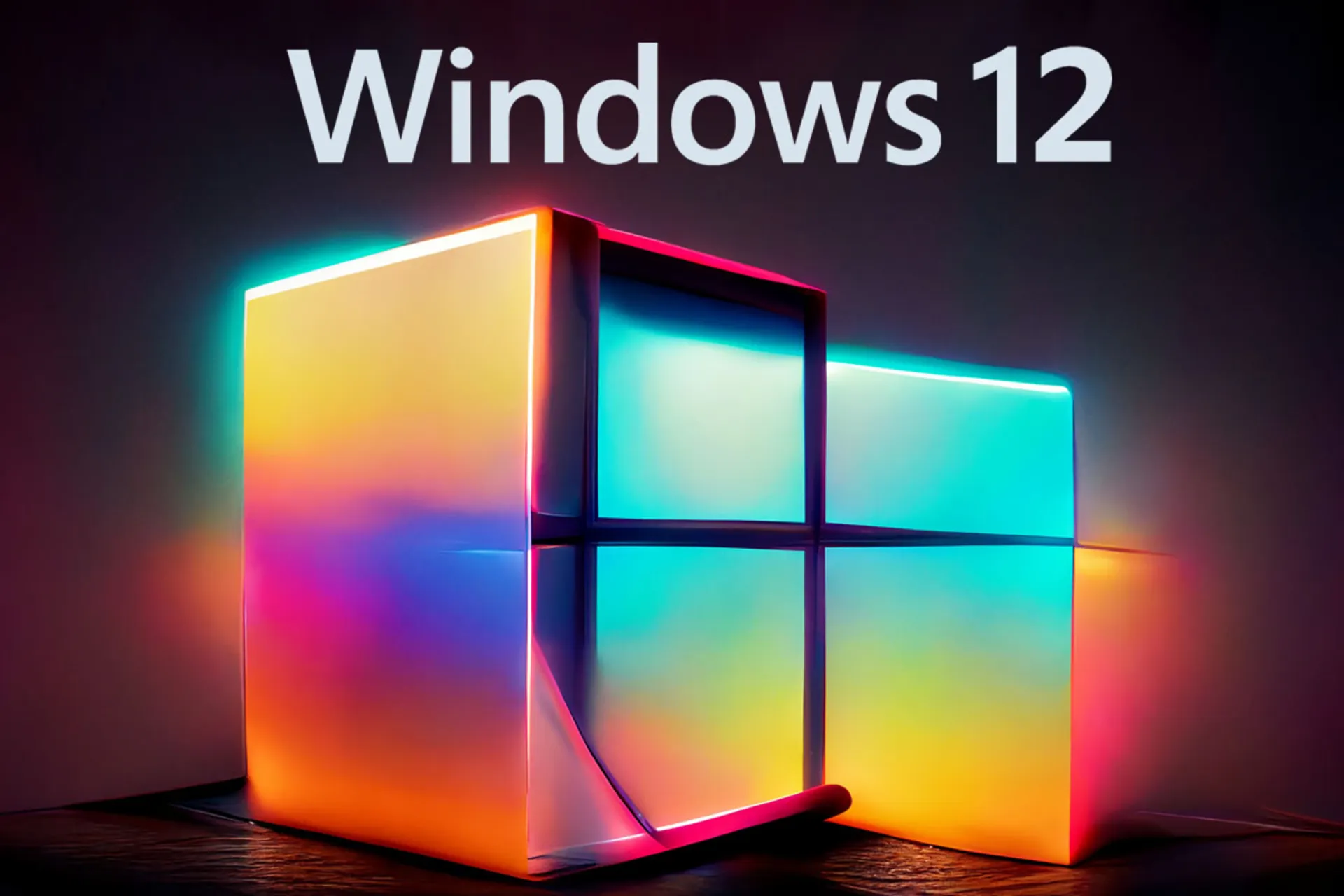
If some of the rumors come true, artificial intelligence will be the cornerstone of the new version of Windows. Microsoft is likely to offer Windows Copilot with more features than BingChat, the company’s former AI-focused assistant, and the gap between Windows and Mac OS in terms of AI processing is gradually narrowing.
Artificial intelligence software
The difference between artificial intelligence software and classic software is in how they process the work you ask them to do. A typical application only provides users with predefined tools, something like specialized tools in a mechanic’s toolbox.
You have to learn the best way to use them, and in order to achieve the highest productivity, you need your own personal experience in using them. In fact, every step of the way, it’s all up to you.
In contrast, AI software can learn by itself, make decisions, and perform complex creative tasks like humans. The ability to learn changes the software model, because the AI program does the work at your request, the way you asked.
This fundamental difference allows AI software to automate complex tasks, or provide personalized experiences. In addition, vast amounts of data will be processed more efficiently and the way we interact with our computers will change.
Artificial intelligence software can learn and make decisions by itself
For example, let’s say you took a photo on your trip by the beach, which is not without problems because, at that exact moment, people appeared in the background of your photo. Normally, you need professional editing tools to remove the parts you don’t want; Especially if you want your photo to look accurate, realistic, and convincing, you may spend hours working on the photo.
But the artificial intelligence software is trained with millions of images of similar landscapes and can “imagine” what the beach looks like without crowds. So instead of using different image editing software, you just click a button and suddenly all the parts that took hours to edit will be deleted.
This example is probably familiar to you and you have seen examples of such functionality in new smartphones. Now imagine when you work with your personal computer, almost all the software works with the same routine according to your wishes. This picture is the long-term horizon of artificial intelligence PCs.
According to Robert Halog, Intel’s director of artificial intelligence, AI software follows different algorithms and runs differently on CPUs. He says:
I recently witnessed an AI create an entire PowerPoint out of nothing. There was no need to tell the program how many slides we needed and in what order, or to specify how to lay them out and break them up into smaller sections. AI takes a blank page from you and delivers what you need for the project.
Technology managers’ vision for AI PCs
Lenovo is one of the companies that play a significant role in the market of artificial intelligence systems. Almost all of the company’s AI systems are developed in collaboration with AMD. Robert Herman, Lenovo’s vice president of business, says:
First of all, Workstation is an artificial intelligence PC that uses a powerful GPU. In addition, the in-system processor and processor-enhanced memory are all building blocks for developing artificial intelligence and directing its operations.
According to Herman, since 2017, Lenovo has expanded the workstation team to work with the AI client side, and since then, it has gradually expanded its way into more customer-friendly products. He emphasizes that we will soon see NPUs and AI engines in personal computers that are perfectly suitable for everyday use.
Jason Banta, head of AMD’s PC OEM division, also acknowledged in an interview that Lenovo was the leader in introducing hardware products that have neural processors and artificial intelligence systems at this year’s CES. He also said:
We’re bringing millions of AI PCs to market, and luckily you’re now seeing developers trying to better understand these products. They want to understand how this technology works on a personal level with their applications and improves their programs.
Banta had said some time ago that artificial intelligence PCs are the revolution of the technology world after the introduction of the graphical interface. According to him, Lenovo’s cooperation with big partners like Microsoft will be a big step in the development of artificial intelligence hardware and software. At the same time, the interest and acceptance of other software developers to learn new AI systems will accelerate the growth of this market.
Lenovo: AI PCs are the revolution of the technology world after the introduction of the graphical interface
Last year, Pat Gelsinger, the CEO of Intel, called artificial intelligence personal computers a big and surprising change in the world of technology at the company’s innovations event last year. Among the companies that have joined the AI PC movement are Microsoft, Dell, and HP.
Qualcomm’s VP of Engineering, Ain Shivnan, at the Snapdragon Summit in October, called the next step in personal computing changes in how hardware is used to provide completely new and more personalized AI experiences to consumers. Satya Nadella, the CEO of Microsoft, also pointed out that high-scale artificial intelligence applications rely on both cloud processing and personal computers:
We will have literally tons of applications and programs, some of which will use local processing models and some will use hybrid models. I think this is the future of artificial intelligence.
What companies are in the hands of the artificial intelligence hardware market?
Business trends research company Gartner has announced that artificial intelligence personal computers will take about 43% of the PC market by 2025, and this figure will reach 60% by 2027. Regardless of the extent to which the above estimates come true, the most important companies involved in the construction of AI hardware are:
Artificial intelligence PCs are expected to account for 60% of global computer sales by 2027.
Nvidia
At the beginning of 2023, when the value of the Nvidia company exceeded one trillion dollars, this technology giant became one of the main players in the artificial intelligence hardware market. Nvidia has released the A100 chip and the Volta GPU graphics processor specifically for data centers and announced its readiness to produce hardware equipped with artificial intelligence for the gaming sector.
Last August, this company introduced its newest product, which uses the HBM3e processor, to the world of technology: the Grace Hopper platform, which has three times the bandwidth and memory capacity of current Superchips.
And finally, Nvidia’s NVLink technology can connect the Grace Hopper super chip to other chips. This technology enables multiple GPUs to communicate with each other through a high-speed connection.
Intel
Intel has achieved a great position in the CPU market with its artificial intelligence products, and this has caused many competitors to accuse this company of monopoly in the field of AI. Although Intel has not overtaken Nvidia in GPUs, the company’s CPUs handle about 70 percent of the world’s data center inference.
As of last fall, Intel had worked with 100 independent software vendors on more than 300 AI-accelerated features to improve PC experiences in audio effects, content creation, gaming, security, streaming, video collaboration, and more.
After the introduction of Core Ultra processors in December, it was announced that this leading product will be used in the design of more than 230 series of laptops. The most important advantages of Intel in the field of artificial intelligence PCs are software activation, scalability, and immediate availability of products.
Alphabet
Google’s parent company offers a variety of products for mobile devices, data storage, and cloud infrastructure. The company has developed Cloud TPU v5e for large language models and generative artificial intelligence, which performs data processing five times faster at half the cost of the previous generation.
Now Alphabet is focused on producing powerful artificial intelligence chips to meet the demand of large projects. In addition, the company has also unveiled Multislice performance scaling technology. The fourth edition of Alphabet TPUs improves floating-point operations by up to 60% in multibillion-parameter models.
Apple
Apple’s chip-based specialized cores, known as Neural Engines, have advanced the design and performance of the company’s AI hardware. This technology was first used in the M1 chips of MacBooks and made the general performance of laptops 3.5 times faster and their graphic performance five times faster than the previous generation.
The success of Apple’s M1 chip led to the introduction of the M2 and M3 series, which benefited from more powerful cores and much better graphics performance.
IBM
After the success of its first specialized artificial intelligence chip, Telum, IBM decided to design a powerful successor to compete with other companies in the artificial intelligence market. This company launched a new specialized department called the Artificial Intelligence Unit in 2022, and its first AI chip uses more than 23 billion transistors and 32 processing cores.
One of the most important differentiators of IBM’s AI vision is that instead of focusing on GPUs, it has shifted to producing mixed-signal analog chips, with improved energy efficiency and competitive performance.
Qualcomm
Although Qualcomm has been a newer and relatively late entrant to the AI hardware market compared to the other competitors we mentioned, its experience in the telecommunications and mobile phone sectors makes the company a serious player in the AI hardware scene.
Qualcomm’s Cloud AI 100 chip beat the Nvidia H100 in a series of benchmarks . In one of these tests, it was found that the Qualcomm chip responded to 227 requests from the data center server per watt, while this number reached 100 requests for the Nvidia chip. In the “object detection” test, the Cloud AI 100 chip managed to prove its superiority to the H100 by responding to 3.8 requests per watt with a rate of 2.4 requests per watt.
Amazon
Amazon shifted its focus somewhat from cloud infrastructure to chips in order to maintain its stock value and technology market share.
For example, the company developed Elastic Compute Cloud Trn1s virtual servers specifically for deep learning and generative AI models. Said servers use the Trainium chip, which is a kind of artificial intelligence accelerator.
The first version of Amazon’s Trn1.2xlarge machine learning instance uses a network bandwidth of 12.5 gigabytes per second and a 32-gigabyte memory instance. The new version of this chip was also released with the name trn1.32xlarge, which has 16 accelerators, 521 GB of memory, and a bandwidth of 1,600 GB per second.
AI PCs, marketing bubbles, or vital technology of the future?
With all the hype surrounding AI these days, it’s no surprise that chipmakers are scrambling to implement AI into their products as quickly as possible before consumer interest wanes.
There’s no doubt that adding NPUs to processors will bring amazing benefits to end users in the long run, but the early waves of AI PCs mostly benefited from trends that hit the mainstream.
Currently, NPU is not considered a revolutionary element for personal computers
The capabilities of artificial intelligence PCs, which we mentioned in the previous sections, are interesting features, but they are still accessible with external and web-based applications. AI PC manufacturers should develop programs that encourage users to upgrade their systems; Otherwise, people’s enthusiasm will subside very soon.
Of course, this issue was also true at the beginning of the release of JPT chat and other artificial intelligence tools. AI chatbots at the beginning seemed more hype than practicality; But as their meaning was more widely and deeply understood, they also became more powerful tools.
Currently, NPUs are not considered a vital and extraordinary element for personal computers. They simply speed up what you’re currently doing with your computer and make programs more efficient, but they don’t change the playing field by themselves. The advancement and ubiquity of AI PCs seem to be in the hands of developers who must use this new chip architecture to create innovative software that brings tangible value to consumers.
Perhaps in the future, when applications bring artificial intelligence to their platforms and new technologies are developed focusing on this technology, there will be a greater difference between normal computers and artificial intelligence PCs.


Can humans endure the psychological torment of living on Mars?


Xiaomi Pad 6S Pro review


Metaverse is back


AI PC; revolutionary technology of the future?


Motorola Edge 50 Pro review, technical specifications


Android 15 features: Everything you need to know 2024 update


One UI 6.1 user interface review; The most complete Android skin


Review of Xiaomi 14 Ultra, price and specifications


What would happen if gravity stopped?


Review of Motorola Edge 40 ; Pure Android in a lovely body
Popular
-





 Technology9 months ago
Technology9 months agoWho has checked our Whatsapp profile viewed my Whatsapp August 2023
-



 Technology10 months ago
Technology10 months agoHow to use ChatGPT on Android and iOS
-



 Technology10 months ago
Technology10 months agoThe best Android tablets 2023, buying guide
-



 Humans1 year ago
Humans1 year agoCell Rover analyzes the inside of cells without destroying them
-



 AI1 year ago
AI1 year agoUber replaces human drivers with robots
-



 Technology10 months ago
Technology10 months agoThe best photography cameras 2023, buying guide and price
-



 Technology10 months ago
Technology10 months agoHow to prevent automatic download of applications on Samsung phones
-



 Health1 year ago
Health1 year agoPefusiX-Imaging is a tool for imaging blood flow

